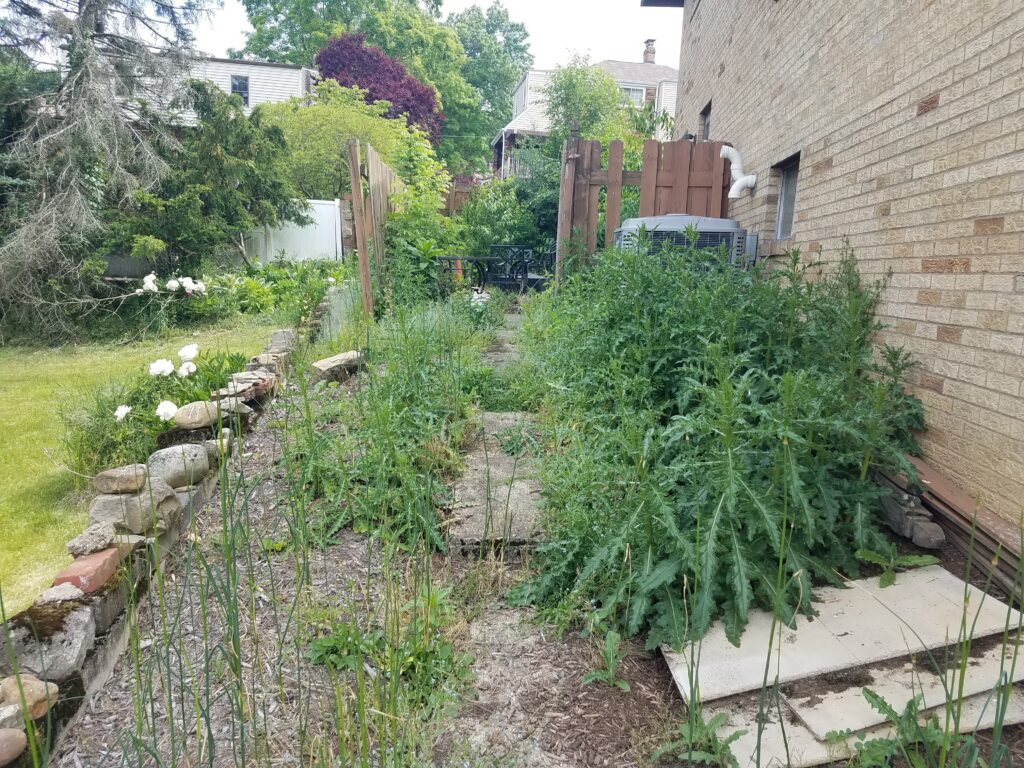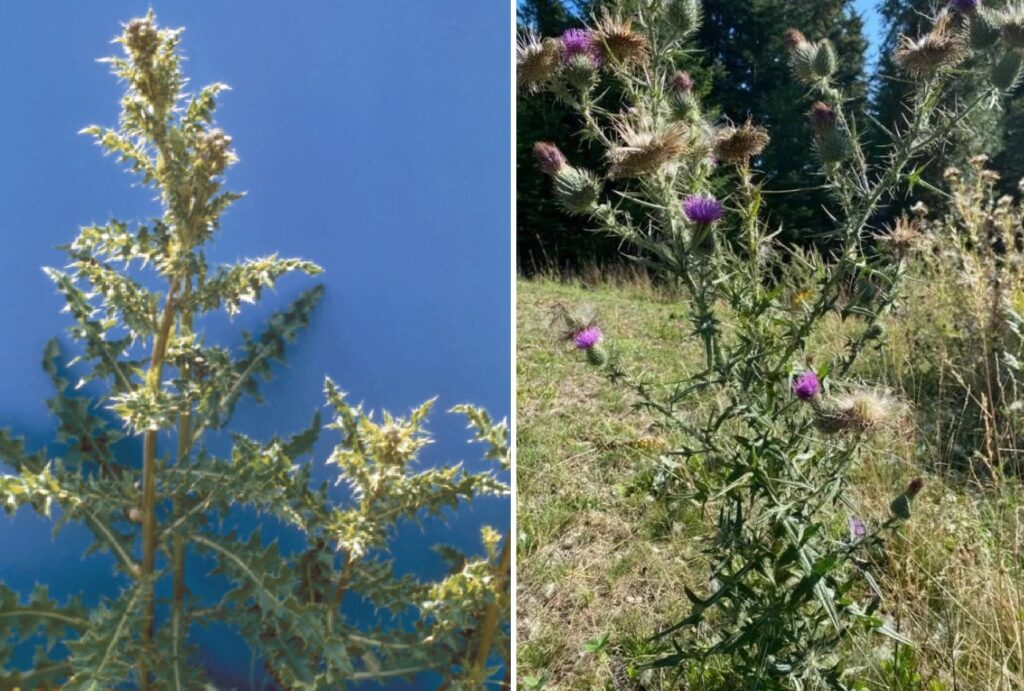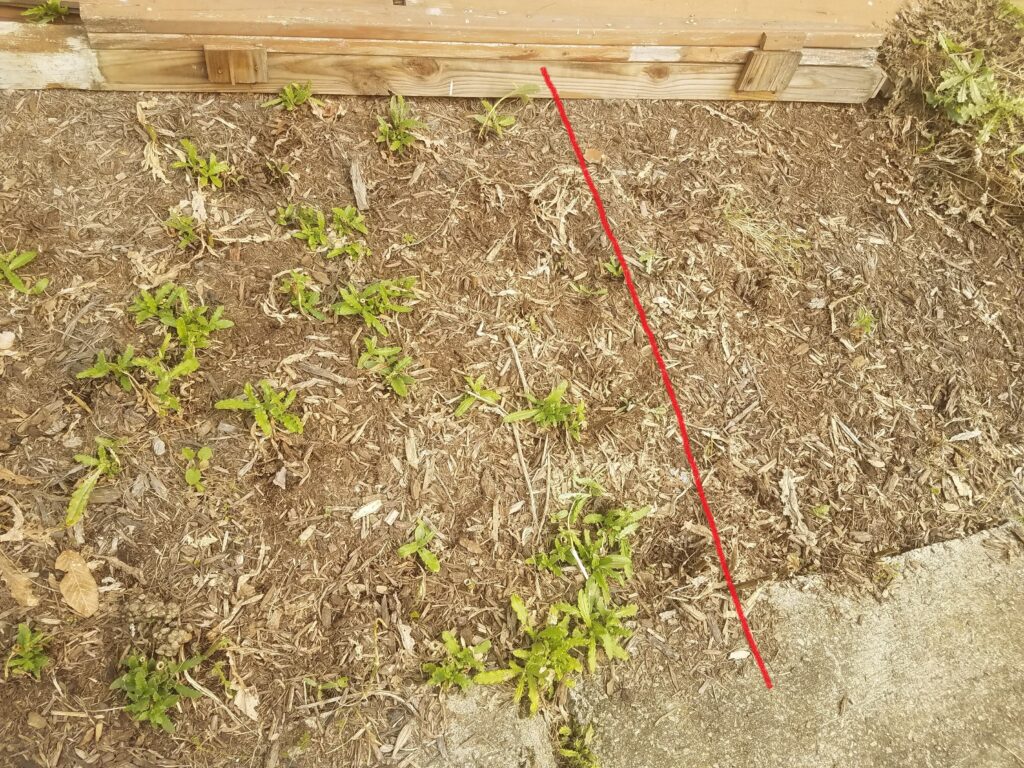Regular readers of this blog will know that I have been optimistically expanding my garden beds with wild abandon every year and valiantly attempting to get new plants in the ground before the weeds take over. I’ve had far more luck in the front of the house, but the garden spaces in the back (which actually used to be garden when the previous owners lived here) remain incredibly stubborn and seem to revert to overgrown wilderness as soon as I turn around. I was hoping to make more progress back there this summer, but that remains to be seen because of one particularly troublesome plant: thistle.

I usually have a few thistle plants pop up every year throughout my yard, but if they show up in an area already populated with other plants, there is competition for space and nutrition, so they don’t have much opportunity for growth. However, about this time last year, I completely cleared and mulched (with a layer of cardboard) the stretch of yard along the back of our house from the driveway to the patio. It was a lot of work, and I was thrilled to have made so much progress so early in the year.
Cirsium arvense
As we got to fall, I still hadn’t planted anything, and a couple baby thistles started to pop their heads above ground. I diligently pulled them out in hopes of staying on top of any new weed growth – rookie mistake. There are multiple kinds of thistle, and it is important to know what you’re dealing with before you try to get rid of it, lest you make things worse, like I did. Canada Thistle (a.k.a. creeping thistle or field thistle) is what I have in my yard, and it spreads by its roots… which it now has – throughout the area I had so proudly cleared last spring.
The reason you are not supposed to pull Canada thistle is because, like a dandelion, a damaged root can send up multiple new shoots. Tilling Canada thistle in a field chops up the roots and spreads them throughout the area, risking a “Sorcerer’s Apprentice” type situation [1] (unless you want to be really diligent and till every two weeks for up to four years [2]). And wouldn’t you know it, after I pulled them last fall, they came back with a vengeance this spring, forming a veritable thicket along both sides of the garden path, after they had clearly spread underneath the concrete walk.

Image credits: Canada thistle [3], bull thistle [4]
Although it’s called Canada thistle, that’s not where it’s from. It is native to southeast Europe and the Mediterranean, likely having been introduced to North America around the 1600s.[5] Although it is a big nectar producer when it flowers, non-native honeybees seem to visit more than native bees, which is not surprising for a non-native plant.[6] It is incredibly aggressive and can be one of the first plants to colonize disturbed ground, which is exactly what happened in my back yard. I like to think that if I had been more on-the-ball with planting after I had finished weeding, the thistle would have had a harder time taking hold. In any case, it has opportunistically colonized the available area, and I need to get working on removing it.
What to do?
The best option for Canada thistle in a small area (e.g. residential garden) is continually cutting them off at ground level to starve the plant of sunlight, and therefore, food. All of the guidance I have seen thus far is very clear that this process will take several years. It is best to let the thistle bolt (grow a stalk) and cut it when it is just about to bloom because it will have used a lot of its energy making flowers and seeds; cutting it then (and returning weekly to cut back any new growth) will leave it weak and vulnerable.[7] Ideally, there will also be other, desired plants around to make the area even less inviting.
My neighbor – the one who laughs at me whenever I’m outside weeding, which is most days between March and October – asked if I couldn’t just spray them with something. I knew she was thinking Roundup, but I explained to her, again, that everything on my side of the wall is organic. However, I did have an organic option: vinegar. Household vinegar can be very effective at killing young thistle growth, and stronger vinegar can work on older plants. An early 2000s agricultural study demonstrated the effectiveness of various concentrations in field applications.[8]

In the past few weeks, I have made use of both of these tactics. Slightly skeptical of how effective my 4% vinegar would be after cutting my thistle thicket down to the ground, I didn’t just spray the stubs with vinegar – the stalks are hollow, and I filled them to the brim with vinegar to make my point. I was perhaps a little too enthusiastic, and my old spray bottle decided it had had enough about halfway through the patch. Although I wanted to continue and could have run out to the store for a new spray bottle, I also couldn’t resist a controlled demonstration of effectiveness. I didn’t expect much, since we were in for several days of heavy rain, but, again, I was wrong.
After the rain stopped later that week, I went back out to look around, and I was pleasantly surprised by what I found. The plants that had just been cut to the ground were sporting new little sprouts all around the base of the original stalks. However, the plants that were doused with vinegar seemed to be doing nothing at all. I’m aware that it will take some time (possibly years) to have a significant impact on the extensive root system, but I am encouraged by how effective the process has been so far.
~
I am, of course, being more sparing and targeted with the application of vinegar in other parts of the yard, where thistle is popping up around plants I want to keep. I know it’s going to be a long process to fully and effectively remove them, but gardening is all about the long game.
Do you have any tried-and-true organic methods for dealing with thistle? I’d love to hear about them below.
Thanks for reading!
[1] https://www.nwcb.wa.gov/images/weeds/Canada-Thistle-and-Bull-Thistle-Control_Whatcom.pdf
[2] https://www.nwcb.wa.gov/weeds/canada-thistle
[3] https://www.nwcb.wa.gov/images/weeds/canada-thistle/thistle_canada_plant.gif
[4] https://www.nps.gov/articles/000/canada-and-bull-thistles-acadia.htm
[5] http://www.iucngisd.org/gisd/species.php?sc=413
[6] https://en.wikipedia.org/wiki/Cirsium_arvense
[7] https://www.gardeningknowhow.com/plant-problems/weeds/canada-thistle-control.htm
[8] https://www.ars.usda.gov/news-events/news/research-news/2002/spray-weeds-with-vinegar
0 Comments